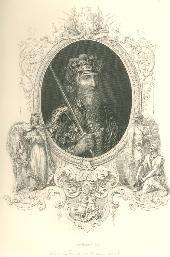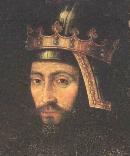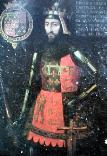See also
- William, 's parents: Jean II d'Avesne (1247- ) and Philippa of Luxumbourg ( - )
William, (1286- )
1. William, Count of Holland and Hainault, son of Jean II d'Avesne (1247- ) and Philippa of Luxumbourg ( - ), was born in 1286. He married Jeanne de Valois.
Jeanne de Valois and William, Count of Holland and Hainault had the following children:
| +2 |
Second Generation
2. Philippa de Hainault, daughter of William, Count of Holland and Hainault and Jeanne de Valois, was born on 24 June 1311. She died on 15 August 1369. She married Edward III KING OF ENGLAND.
Philippa won much popularity with the English people for her kindness and compassion which was demonstrated in 1347 when she successfully persuaded King Edward to spare the lives of the Burghers of Calais. It was this popularity that helped maintain peace in England throughout Edward's long reign.
Edward III KING OF ENGLAND, son of Edward II KING OF ENGLAND of Caernarfon (1284-1327) and Isabelle de France (aft1292- ), was born on 13 November 1312. He had the title 'King of England'. He died in 1377. He and Philippa de Hainault had the following children:
| +3 | |
| +4 | |
| +5 |
Third Generation
3. Edward, the Black Prince, son of Edward III KING OF ENGLAND and Philippa de Hainault, was born in 1330. He died in 1376.
Prince Edward, the eldest son of King Edward III and Queen Philippa of Hainault, was born at the Royal Palace of Woodstock in Oxfordshire, on the 15th June 1330. In his third year, he was created Earl of Chester; four years afterwards Duke of Cornwall; and, in 1343, Prince of Wales.
At the institution of the Order of the Garter, Prince Edward had not completed his fourteenth year; and, although included amongst the Founders, in accordance with the design of his royal father that the eldest son of the Sovereign should be always a constituent ember of the Order, the honour of knighthood was reserved for the moment when he should be armed and thereby qualified to enter upon his warlike course. This occasion presented itself when, accompanying the King on his memorable expedition against France, he landed at La Hogue on the 12th July 1346.
At the Battle of Crécy, which was fought on the 26th August following, King Edward, desirous that his noble son should "win his spurs," gave him the command of the van, with the counsel and assistance of the Earl of Warwick and Sir John Chandos. The tradition near the spot is, that the King had ordered the Prince to wear, on that day, a black cuirass, richly ornamented; and that, from this incident, he retained the surname attributed to him in history. The defeat of the enemy is known to have been complete; and the delighted father, embracing his son on the field of victory, eulogised his valour and pronounced him worthy of empire.
The magnificent establishment provided for Prince Edward in his early infancy, by his investiture with the ample domains of the County Palatine of Chester and the Duchy of Cornwall, had placed a vast revenue at his disposal as soon as he arrived at an age to administer his own affairs; and we have contemporary testimony of the brilliancy of his court, not only during his residence in England, but especially whilst exercising the supreme authority in Aquitaine.
From a highly interesting volume, unknown to his various biographers, and containing the warrants and accounts of the treasurers and other officers of his household from 1346, and, in a regular series from February 1351 to November 1365, we learn that, upon his return from Calais, in 1347, his town residence was "Pulteney House," situated in or near Candlewick Street, in the parish later called St. Lawrence Pountney in the City of London. This mansion, which had been erected, by Sir John Pulteney (who frequently filled the civic chair), on the site of the later Cold Harbour Palace, is described as having been built on a scale of great splendour. It was, at some time after the death of Sir John, which happened in 1340, and during the minority of his son, tenanted by the Prince, until 1359, in which year directions were given to surrender it to Sir Nicholas Loveyne, who had married the knight's widow. Its front was open to the Thames, where the prince kept swans in considerable number, to which allusion is often made in these accounts. The Prince's country residences appear to have been chiefly Berkhamstead Castle (Herts), Wallingford Castle (Berks), Northbourne near Sandwich (Kent), Byfleet (Surrey) and Kennington Manor (Surrey) near London.
The above-mentioned volume abounds with proofs of the generous use which Edward made of his wealth in the distribution of costly presents amongst the members of his august family, his gallant companions in arms and his numerous retainers, as well as in princely guerdons to strangers of every rank who had the fortune to attract his regard.
At the expiration of the truce with France, on the 24th June 1355, he began to prepare for his departure for Gascony, invested, as the King's lieutenant, with the government of all his French possessions. By an indenture dated at Westminster 10th July in that year, made between the King, on the one part, and the Prince of Wales, on the other, it was stipulated that the Prince should be attended by 433 men-at-arms and 700 archers, of whom 400 should be mounted and 300 on foot; which force - as well as the men-at-arms and archers of the Earls of Warwick, Suffolk, Oxford and Salisbury, Sir John de Lisle and Sir Reginald de Cobham - should constitute the proper retinue of the Prince, and be paid by the King for one half-year in advance, reckoning from the day of their embarkation; and, for carrying into effect the several provisions of this agreement, the Duke of Lancaster, and the Earls of Northampton, Arundel, March and Stafford, pledge their loyal aid and counsel.
The Prince appears to have had his headquarters at Plympton (Devon) from 8th August until 2nd September, and to have issued, from thence, several warrants to his treasurer and other officers in London. On 4th of the latter month, we find him at Plymouth (Devon). On 7th, there is a warrant for vestments for the priests of his chapels at Wallingford and Berkhamstead; gifts of musical instruments to the minstrels sent to him by the Count of Eu; and for the cost of "a round plate, gilt and enamelled with the arms of the company of the Garter, which we gave to William de Stafford, Herald of Arms, and of three garters, the one of gold, the other enamelled with an eagle and the third, a common silver garter, enamelled and gilt, which we have received for our own use."
In the course of that month, he arrived at Bordeaux; and from 20th, commences an interesting journal of his expenses, still extant in the office of the Duchy of Cornwall. On Monday, 5th of October 1355, the Prince marched out of that city, with a powerful army, in order to encounter the French forces then stationed in Languedoc; and both Froissart and Stowe enumerate the places through which he passed in his progress. The journal of expenses supplies several dates in authentication of the line of march. On the 19th September 1356, the Battle of Poitiers, gained by the English army, greatly inferior in number to that of France, was chiefly directed by the military genius of Edward; and King John of France was conducted a prisoner to Bordeaux, and from thence to London, where he made his celebrated entry 24th May 1357.
After the proofs given by the Prince, during his government in Aquitaine, of his talents, not only as a military commander but as a statesman, he appears to have borne an important part in the direction of public affairs. By an instrument, dated London, 6th September 1357, he appointed Henry, Lord Percy and Ralph, Lord Neville to swear on his behalf to the observance of the treaty to be concluded between the King, his father, and his council and the prelates, nobles and others of the Kingdom of Scotland, concerning the liberation of "David de Bruys, a prisoner of our Lord the King."
In 1362, the King created his victorious son, Prince of Guienne and Gascony, and erected those provinces into a principality for the term of his life. Edward proceeded immediately to his new territories, accompanied by his princess; and held his court with great state and magnificence at Poitiers, to which city the barons and knights of Poitou and Saintonge repaired, to do him fealty and homage, and where he was also visited by Peter de Lusignan, King of Cyprus. On the latter occasion, the Prince gave a Royal joust of forty knights and as many esquires in honour of the birth of his son, Edward.
During the residence of Prince Edward at Bordeaux, his aid was personally solicited by Peter "the Cruel," King of Castile, towards the recovery of his kingdom, from which he had been driven by his illegitimate brother, Henry of Transtamare. King Edward concurring, the Prince entered Spain at the head of 30,000 men and, after a severe contest at Najara (about fifty miles south of Bilboa) on 3rd April 1366, restored the ungrateful monarch to his throne.
From this expedition, Edward is said to have returned to Bordeaux with the seeds of a malady which never quitted him. His spirits having also suffered great depression from the loss by death of his eldest son, Edward, he left the prosecution of the continental war to his brothers, the Duke of Lancaster and Earl of Cambridge, and, embarking with the Princess and their only surviving child, Richard, arrived at Plymouth in January 1371. Two years afterwards, he surrendered the principality of Guienne into the King's hands and, from that period, seems to have taken little interest in public business; exhibiting a melancholy example of the instability of all human glory.
He made his will, in the King's Great Chamber at Westminster, on 7th June 1376; and, to the great grief of the nation, expired there on the day following. His body, having been embalmed, was kept until the meeting of Parliament at the ensuing Michaelmas, in order that it might be interred with the greater solemnity. This was performed at Canterbury, near the shrine of St. Thomas A'Becket; and a stately monument, still extant, was thereupon erected to his memory.
By his consort, Joan, who in her youth had been named the "Fair Maid of Kent," the sister and heir of John Plantagenet, Earl of Kent, and relict of Sir Thomas Holland, in her right, also Earl of Kent (to which lady the prince was married in the Royal Chapel of St. George at Windsor Castle (Berks) on Sunday 10th October 1361), he had two sons, Edward, born at Angoulême on 27th January 1365, who died at Bordeaux, in the sixth year of his age; and Richard, afterwards King Richard II.
Edited from George Frederick Beltz's
"Memorials of the Most Noble Order of the Garter" (1861).
4. Lionel of Antwerp DUKE OF CLARENCE, son of Edward III KING OF ENGLAND and Philippa de Hainault, was born on 29 November 1338 in Antwerp, Holland. He died on 7 October 1368 in Alba, Italy. He married Elizabeth de Burgh.
Lionel of Antwerp, Duke of Clarence (November 29, 1338 ?October 7, 1368) was the second son of Edward III of England and Philippa of Hainault. He was so called because he was born at Antwerp, Belgium.
Betrothed when a child to Elizabeth de Burgh, 4th Countess of Ulster (d. 1363), daughter and heiress of William Donn de Burgh, 3rd Earl of Ulster (d. 1332), he was married to her in 1352, but before this date he had entered into possession of her great Irish inheritance. He was called Earl of Ulster from 1347.
Having been named as his father's representative in England in 1345 and again in 1346, Lionel joined an expedition into France in 1355, but his chief energies were reserved for the affairs of Ireland.
Appointed governor of that country, he landed at Dublin in 1361, and in November of the following year was created Duke of Clarence, while his father made an abortive attempt to secure for him the crown of Scotland. His efforts to secure an effective authority over his Irish lands were only moderately successful; and after holding a parliament at Kilkenny, which passed the celebrated Statute of Kilkenny in 1367, he dropped the task in disgust and returned to England.
Lionel's wife died in Dublin in 1363, leaving behind a daughter, Philippa, whose descendants would one day claim the throne for the House of York. A second marriage was arranged for Lionel with Yolande or Violante, daughter of Galeazzo Visconti, lord of Pavia (d. 1378); the enormous dowry which Galeazzo promised with his daughter being exaggerated by the rumour of the time. Journeying to fetch his bride, Lionel was received in great state both in France and Italy, and was married to Violante at Milan in June 1368. Some months were then spent in festivities, during which Lionel was taken ill at Alba, where he died. There was strong speculation at the time that he had been poisoned by his father-in-law [1] although this has never been proven.
His only child, Philippa Plantagenet, married in 1368 Edmund Mortimer, 3rd Earl of March (1351-1381). They were grandparents to Anne Mortimer, great-grandparents to Richard Plantagenet, 3rd Duke of York and great-great-grandparents to Edward IV and Richard III.
The poet Geoffrey Chaucer was at one time a page in Lionel's household.
Elizabeth de Burgh, daughter of William de Burgh, 6th Lord of Connaught and 3rd Earl of Ulster ( - ), was born in 1332. She died in 1363 in Dublin. She and Lionel of Antwerp DUKE OF CLARENCE had the following children:
| 6 | Philippa Plantagenet of Clarence (1355- ). Philippa was born in 1355. |
5. John of Gaunt DUKE OF LANCASTER, son of Edward III KING OF ENGLAND and Philippa de Hainault, was born in March 1340. He had the title 'Duke of Lancaster'. He married Katherine ROET in 1396. He died on [Julian] 3 February 1399. He married Blanche of Lancaster. He married Constance QUEEN OF CASTILE AND LEON.
This prince, the fourth son of King Edward III and Queen Philippa, was born at Ghent (or Gaunt) in Flanders, in 1340. In his infancy, he was created Earl of Richmond and, by that title, admitted into the Order of the Garter upon the death of Thomas Holland, Earl of Kent, one of the original knights. In 1359, at Reading Abbey (Berks), he married Blanche, the younger of the two daughters and co-heirs of Henry, Duke of Lancaster, and upon the death of his father-in-law, in 1361, he was advanced to that Dukedom. He held also, in right of his wife, the Earldoms of Derby, Lincoln and Leicester, and the high office of Steward of England.
John of Gaunt, Duke of Lancaster (March 6, 1340 ?February 3, 1399) was the third surviving son of King Edward III of England and Philippa of Hainault. He gained his name "John of Gaunt" because he was born at Ghent in 1340. The fabulously wealthy Gaunt exercised tremendous influence over the throne during the minority reign of his nephew, Richard II, and during the ensuing periods of political strife, but took care not to be openly associated with opponents of the King.
Constance QUEEN OF CASTILE AND LEON was born in 1354. She died in 1394.
Katherine ROET, daughter of Sir Pain DE ROET ( - ), was born circa 1350. She died on [Julian] 10 May 1403. She and John of Gaunt DUKE OF LANCASTER had the following children:
| 7 | John de Beaufort EARL OF SOMERSET (aft1371-1410). John was born between 1371 and 1373. He had the title '1st Earl of Somerset'. He married Margaret de Holand on 23 April 1399. He died on 16 March 1410 in Hospital of St. Katherine-by-the-Tower, London. |


